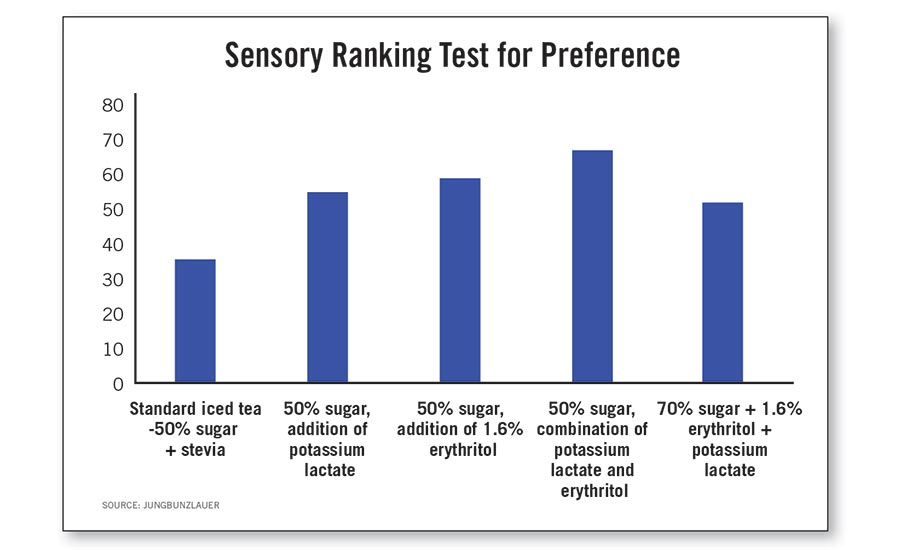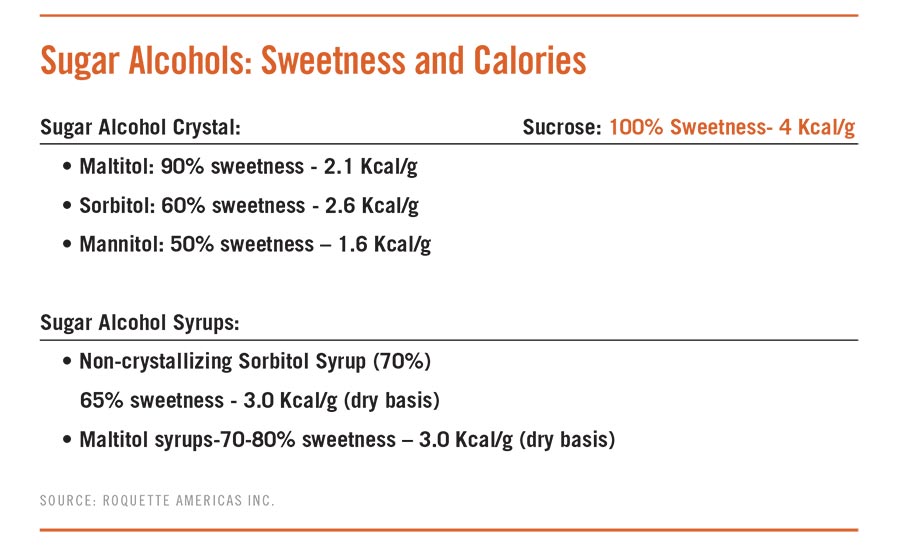Consumers overwhelmingly say they’d like to reduce their sugar intake, but they also tend to shun products with artificial sweeteners. Taste and texture are, as always, of primary importance, as well. Prepared Foods’ seminar speakers shed some light on the complex problems inherent in formulating product with reduced sugar content.
Taste Improvement Solutions for Sugar Reduction
Consumers say that they would like to avoid added sugar, reduce total sugar and avoid artificial sweeteners. However, purchasing behavior indicates that taste is still very important. Some governments are taxing sugary products, and in the US, new regulations require labeling of “Added Sugars.” To satisfy market demands, innovations should be healthy, lower in sugar, natural and tasty.
“What happens when sugar is reduced,” explained Caitlin Jamison, market development, health and nutrition, for Jungbunzlauer, “is that flavor and sweetness intensity are reduced, as well as mouthfeel, gelling and suspension. Off-tastes, like bitter and metallic, are increased, and harsh notes from acids, vitamins and minerals are more apparent.” The title of Jamison’s R&D Applications Seminar was “Taste Improvement Solutions for Sugar Reduction.”
Factors to consider regarding sugar reduction include sensory, stability, regulatory status, natural or artificial, availability, consumption thresholds, solubility, crystallization, caloric value and cost. Tools to help with sugar reduction are available and usually work best in combination. Tools include sweetener systems with both high-intensity and bulk sweeteners. Buffer systems help mask off-flavors, enhance desirable flavors and improve flavor stability. Acids balance the buffer system with various types and ratios of different acids. And the flavor system balances the level of flavor, flavor modulators and flavor types.

Bulk sweeteners include natural sugars, sucrose, fructose, allulose, erythritol or artificial polyols, such as sorbitol, maltitol and xylitol. High-intensity sweeteners to use with these could include natural choices, like stevia or monk fruit; or artificial aspartame, sucralose or acesulfame potassium. Jamison went on to explain, “It is nearly impossible to achieve substantial sugar reduction without the inclusion of some high-intensity sweeteners. And bulk sweeteners are important to include, as they help provide mouthfeel, masking, and [produce] a more rounded product.”
Buffers allow a system to display the desired sourness and tartness, while maintaining pH. Common buffers include citrates, phosphates and gluconates. Lactates are used in meats and confectionery, but are less common in beverages. The inclusion of a buffer has an impact on flavor profile, and the buffer chosen can influence product flavor characteristics in different ways. Certain buffers can also provide masking properties that help in sugar reduction. For example, sodium gluconate masks off-flavors from high-intensity sweeteners, as well as metallic notes from minerals and hydrolyzed proteins. It also stabilizes minerals; reduces the bitterness of caffeine; and is low in cost.
Reduced-sugar black currant ice tea test formulas were measured for sensory evaluation; the highest preference was for the product with 50% sugar and a combination of potassium lactate and erythritol, over other sweetener and buffer combinations. This concept is ideal for 50% reduced sugar and is even promising to reduce sugar more to 70%.
Jamison notes that certain acids, sweeteners and buffers are covered under FEMA GRAS and can be included in formulations as flavors, based on the appropriate regulatory guidance and usage levels.
In summary, improving the taste of a sugar-reduced product requires a view of multiple formulation components. Many topics mentioned here are directly applicable to beverages, but the same tools can be applied to other categories, including salad dressings, sauces, confections, and other sweet and savory categories.
While each of the components discussed here have their limitations, when used in combination, minor changes can be used synergistically to obtain an optimized product with substantial sugar reduction.
“Taste Improvement Solutions for Sugar Reduction,” Caitlin Jamison, market development, health and nutrition, Jungbunzlauer, 617-454-7811, Caitlin.jamison@jungbunzlauer.com
—Summary by Elizabeth Pelofske, Contributing Editor
Sugar Reduction and Sugar-free Confectionery Applications
According to statistics from the Center for Disease Control regarding US Adult and Childhood Obesity, more than one third of US adults are obese. Furthermore, for children and adolescents aged 2-19 years, there has been a steady obesity prevalence at ~17% (12.7 million) for the past decade (as of 2011-2012 information). The danger of obesity-related conditions, include leading causes of preventable death, such as heart disease, stroke and type 2 diabetes.
These sobering statistics were given by Leslie Kleiner, MS, food scientist, Confectionery Applications, Roquette Americas Inc., in her Prepared Foods’ R&D Applications Seminar titled “Sugar Reduction and Sugar-free Confectionery Applications.”
Because of the prevalence of obesity and its associated preventable diseases, the World Health Organization recommends in its dietary guidelines that total fat should not exceed 30% of total energy intake; it also recommends limiting intake of free sugars to less than 10% of total energy intake, keeping salt intake to less than 5g/day to reduce risk of CVD, and that calories-in should balance calories-out.
So, what can food formulators do?
Kleiner specifically addressed the challenges and opportunities in reducing sugar in confectionery applications. Free sugars refer to monosaccharides (e.g., glucose and fructose) and disaccharides (e.g., lactose and sucrose [“table sugar”]). These sugars can be naturally found in honey, fruit juices, fruit juice concentrates and syrups, among other sources. They also can be found as added ingredients to many foods and beverages.
Sugars in non-chocolate confectionary include sucrose as a major bulk sweetener and glucose syrup to control crystallization. Ratios of sucrose and glucose syrup depend on the type of candy, Kleiner explained. In general, non-chocolate confectionery is comprised of glassy (e.g., hard-boiled candy), non-grained candy (e.g., gummies) and grained candy (e.g., fudge, some chews and others).
“Grained candies are sweets with a percentage of the formulation in crystalline form,” said Kleiner. Sucrose is usually the grained component. Further examples of grained candy include grained mints, fudges, fondants, chewy candies and taffy. Fully crystalline candy, such as compressed mints, are made of compressible sucrose and/or dextrose; these direct compressible sugars tend to be costlier than their non-direct, compressible form.
Sugar alcohols are sugar derivatives in which the carbonyl group of the sugar has been reduced to an alcohol group. (See chart “Sugar Alcohols—Sweetness and Calories.”)

There are both benefits and challenges to using sugar alcohols. Benefits include calorie reduction (~50% compared to table sugar), reduced glycemic response, tooth-friendly characteristics (mono and di-saccharides polyols and some polyol syrups), heat-stability. Plus, they provide bulk and sweetness with a clean flavor profile.
Challenges to formulating with sugar alcohols include their digestive tolerance (which varies between polyols, but is not likely to reach tolerance limits if eating recommended serving sizes). Another challenge is that there might be a need to boost sweetness using a high-potency sweetener. And most of them are generally not considered natural, even when many can be found in nature (such as sorbitol in cherries).
Kleiner indicated that fibers also can be used in confectionery for sugar reduction. Soluble fibers include high-viscosity fibers, such as xanthan, guar gum and pectin, as well as low-viscosity fibers, such as resistant dextrins, soluble corn fiber, polydextrose, inulin and fructooligosaccharides. Soluble fibers of low viscosity are useful for bulking in confectionery products.
The use of fibers has its own benefits and challenges. Benefits include calorie reduction, possible fiber claims, bulk with a clean flavor profile, heat-/acid-stability (depending on the fiber type), and that are generally well-tolerated (especially those that are dextrose-based). In addition, many can be considered natural; some are even non-GMO.
Challenges to using fibers start with them having “little to no sweetness.” Also, if the fibers are fructose-based, they are not as acid-/heat-stable as dextrose-based ingredients. Fructose-based fibers may also cause digestive discomfort at moderate levels. Kleiner also cautioned that high levels of some fibers can inhibit gelation of gelatin and, because some fibers have free sugars, the content of free sugars needs to be checked with fiber supplier.
Some of the possible product claims in US for confectionery with soluble fiber include: “reduced calories” (min 25% fewer calories vs standard product); “low calories” (min 50% fewer calories vs. standard product); “reduced sugars” (min 25% sugar reduction vs. standard product); and “sugar-free” (<0.5g of sugars per reference amount).
For confectionery applications, maltitol provides the closest replacement for sucrose, said Kleiner, but other crystalline polyols may be used when reformulating. Polyglucitols are closest in properties to the low-to-medium DE syrups (<42 DE); maltitol syrups with high maltitol content are particularly good to replace 63 DE glucose syrup.
The possibilities for sugar reduction and sugar-free confectionery are broad. Examples are: reduced-sugar gummies with fiber, reduced-sugar yogurt coating also with fiber, sugar-free dark chocolate with maltitol instead of sucrose, sugar-free compressed mints and others.
In conclusion, sugar alcohols and soluble fibers can be used in confectionery applications for sugar-free and reduced-sugar and calories. Furthermore, many claims can be made in the US when using these ingredients. Since when using these ingredients, the processes for candy-making are similar to traditional ones, many reduced-sugar and -calories confectionery applications can be achieved with sugar alcohols and soluble fibers.
“Sugar Reduction and Sugar-free Confectionery Applications,” Leslie Kleiner, MS, food scientist, Confectionery Applications, Roquette Americas Inc., leslie.kleiner@roquette.com
—Summary by Barbara T. Nessinger, Contributing Editor
Originally appeared in the June, 2017 issue of Prepared Foods as Sweetener Strategies.
